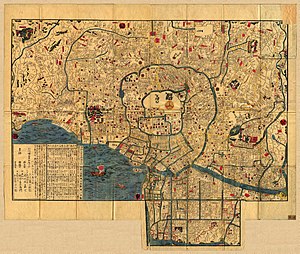

Fires in Edo (江戸), the former name of Tokyo, during the Edo period (1600−1868) of Japan were so frequent that the city of Edo was characterized as the saying "Fires and quarrels are the flowers of Edo"[note 1] goes.[1] Even in the modern days, the old Edo was still remembered as the "City of Fires" (火災都市).[2]
Edo was something of a rarity in the world, as vast urban areas of the city were repeatedly leveled by fire.[3] The great fires of Edo were compared to the gods of fire Shukuyū (祝融) and Kairoku (回禄), and also humorously described as "autumn leaves".
Cite error: There are <ref group=note> tags on this page, but the references will not show without a {{reflist|group=note}} template (see the help page).
- ^ Tenrai 2007.
- ^ Nishiyama 1974, pp. 5–20.
- ^ Nishiyama 1978, p. 84.